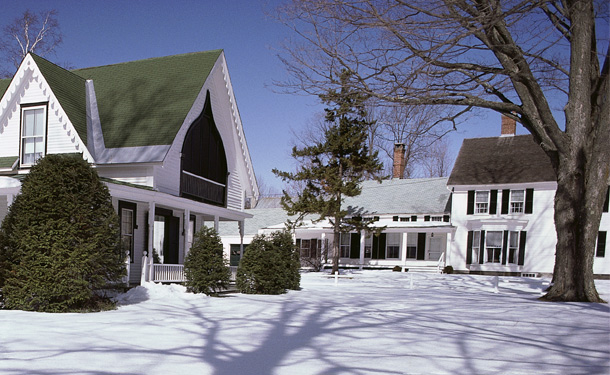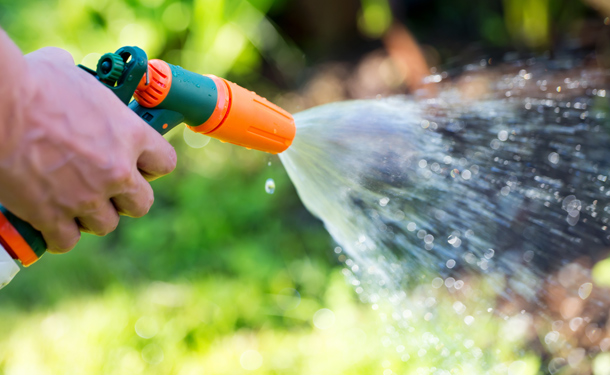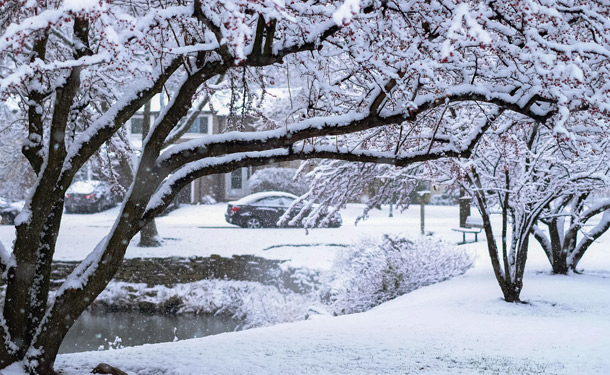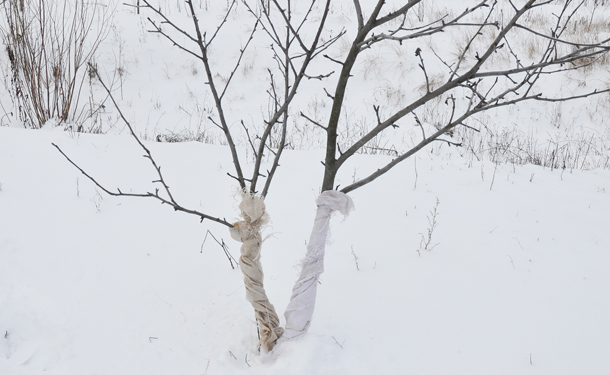With winter right around the corner, it’s time to take measures to protect some of your greatest garden investments. Ornamental shrubs, young shade trees, deciduous, and evergreens will need some help to make it through harsh winter weather.

Heavy snow and accumulated ice can break limbs and branches or even topple a tree all together. Evergreens can suffer bleaching from cold temperatures, winter sun and wind, and further damage can be caused to the roots, bark, and branches can be injured or killed.
As food sources become sparse in the coldest months, deer and rodents will seek out bark, foliage, buds, and twigs. If left unattended, this foraging can severely injure and possibly kill your trees, shrubs, and plants.
Don’t give up! There is hope. The following will help you lend a hand to your garden and landscape occupants throughout the harshest weather this winter may bring.
Protecting and Hydrating Tree, Plant and Shrub Roots
That’s right, it all starts with the roots. In the fall, right up to the first freeze, there are two steps you can take to ensure proper hydration and root protection. Understand that soil temperatures drop much more slowly than air temperature and that roots of most trees will begin to die if the soil reaches temperatures below 10°F.
Fall Watering – Evergreens, newly planted trees and woody plants need to be watered frequently during the fall (especially during a dry fall season). During a deep freeze (when the ground freezes) roots can no longer absorb moisture from the soil and become dependent on what they’ve stored in the fall.

NOTE: The primary cause of winter damage to evergreens is from dehydration. Evergreens don’t lose their foliage in the winter and will continue to transpire. If they haven’t stored sufficient water, they may suffer burning or browning of the foliage.
Thick Mulching – As previously mentioned, soil temperatures below 10°F can cause severe damage and kill the roots of most trees. While it may seem counterintuitive, moist soil is able to hold more heat than dry soil. In order to maximize root growth in the fall and minimize winter root injury, a 3 to 6 inch layer of wood chips or organic mulch should be used around your trees, plants, and shrubs.
NOTE: If you live in an area where the temperature remains at or below freezing for extended periods of time, you should mulch your trees, shrubs, and plants with 6 to 8 inches.
Visit thetreecareguide.com/how-trees-survive-winter-months/ to understand how trees survive the winter months so you can better aid them.
Severe Cold Weather Damage and Your Hardiness Zone
The health and longevity of your landscape begins with the selection of trees, shrubs, and plants appropriate for your hardiness zone. Unless kept in and protected by a microclimate, plant life that is not hardy in your hardiness zone may be severely damaged or killed during the winter months.
Your plant life sustains the most damage when pronounced temperature fluctuations occur during the fall, winter, and spring. Prolonged low temperatures in early fall and late spring will potentially cause the greatest damage, as well as “tripping up” the dormancy or “awakening periods for deciduous trees, shrubs, and plants. This damage may occur regardless of the hardiness zone location, but plant life that thrives in your zone will have a better chance at recovery.
Visit http://planthardiness.ars.usda.gov/PHZMWeb/ to find out which hardiness zone you are located inside.
Avoid Tree and Shrub Damage from Snow and Ice Storms
Ice and snow accumulation can get heavy enough to bend and eventually break both deciduous and evergreen branches. Evergreens like junipers and multiple leader (clump trees) like birch are highly susceptible to this type of damage.

NOTE: The proper pruning and trimming of your trees and shrubs (to eliminate multiple leaders and weak branches) will help to avoid damage caused by snow and ice accumulation.
Tying leaders together, cabling larger trees, or wrapping smaller trees is an option. Seek assistance from a tree professional, the improper application of these alternatives can cause more harm than good. These ties, wraps, and cablings must be removed in the spring to avoid girdling and return free movement to the stems and branches.
Prevent Deer, Rabbits, and Rodents from Feeding on Your Trees
Deer, rabbits, and rodents will begin to feed on foliage, twigs, and bark as their normal food sources become unattainable in the winter months. The foraging of these animals poses a great threat to the health and life of your trees, shrubs, and plants. Here are some simple solutions like trunk wrapping to keep your landscape safe from these critters and their appetites:

Plastic Tree Guards – Putting plastic tree guards around the bottom of your trees (especially young or newly planted trees) will keep rabbits and mice from feasting on them. If you live in areas which accumulate snow, the guards should be well above the snow line. Otherwise, your efforts will be in vain.
NOTE: Once spring arrives, remove the guards. They can cause the trapping of moisture in the bark, attracting insects and possible infestation issues.
Chicken Wire Barriers – This is the best solution for rabbits. Erecting chicken wire fences/cages around your trees, shrubs, and plants will keep them out of harm’s way.
NOTE: This is a solution which can be employed at any time of the year and kept in place until the rabbit issue is properly dealt with.
Deer and Pest Repellent Spray – Applying a repellant spray to the trunks, branches, and stems of your trees is a great option, especially if you have numerous trees on your property. Repellant sprays are easy to come by at nurseries and home supply stores that have a gardening department.
NOTE: Rain will wash away most repellents. If you are experiencing a wet season in your geographic location, you will need to reapply the repellant after heavy rain storms.
Trunk Wrapping for Deer Prevention – Deer love to rub their antlers on tree trunks. That said, if you live in an area where deer graze, it is a prudent idea to wrap your most vulnerable tree trunks. Take a look at the following video for a smart and inexpensive way to wrap your tree trunks.
Is Tree Wrapping Necessary?
No – If you have chosen evergreens according to your location on the USDA Hardiness Zone Map, and they’ve had time to establish their root systems, the answer is no.
Yes – For newly planted evergreens and those that are prone to dehydration and winter-burn, the answer is yes. They should be wrapped for the winter season.
NOTE: As mentioned above, dehydration occurs in evergreens because the never stop transpiring throughout the winter. Thus, if they haven’t stored enough water in the fall (or are unable to attain sufficient water in the winter), your evergreens will most likely suffer winter-burn.
For more on tree wraps, visit extension.umn.edu/garden/yard-garden/trees-shrubs/protecting-from-winter-damage/
Save Evergreens, Trees, and Shrubs with Preparation and Common Sense
Knowing your location on the hardiness zone map and planting accordingly is the beginning to a successful landscape. Using common sense throughout the year by properly pruning, trimming, protecting, and watering your plants, shrubs, trees, and evergreens will keep them alive and vibrant for many years.
Every winter provides a different set of challenges and every plant responds differently to those stressors. While plants, shrubs, and trees are remarkable in their ability to adapt, they often need your assistance to avoid severe damage, illness, and infestations. Consulting a local tree professional will help you decide which methods to employ to keep your landscape alive and healthy on the other side of the coldest months of the year.